We’re up to four hives now, if all works out, which is kind of funny because our aim has always been two.
But, here’s the thing: Strong hives swarm. If a beekeeper wants to try to prevent that, we have to split them before they get too crowded.
Ergo, we have four hives.
You may recall a month ago, when we had a plan to split California Girls and ended up splitting Buzzers’ Roost instead because they were building queen cells.
Well, Cali Girls have only gotten more crowded, and Saturday was the day to split them. We had to wait a month because we treated both big hives with Formic Pro, which is effective, but has always resulted in bee loss for us. Last year, when we treated, we lost two queens during the course of the treatment.
Naturally, correlation does not equal causation, and there were a lot of queen problems last year, so the two facts may have been unrelated.
Still … this year, we chose to do the“one strip” treatment, putting in a single Formic Pro strip for ten days, and then replacing it with another for an additional ten days. (The other option is a single fourteen-day treatment with two strips.)
This meant we couldn’t do anything with the main hives for twenty days. And we didn’t want to mess with the split until they had a chance to requeen, though last week we did take peek, and saw no signs of eggs, larvae or a queen.
Meanwhile, California Girls were bearding like crazy, so we knew they were getting cramped. Bearding is something bees do on hot days, but Cali Girls were doing it all the time.
And I mean All. The. Time. Morning, day, and night. Before the recent hot weather even arrived.
They looked kind of like the picture below, which is actually from today (90s and quite humid).
Look at the hive next to them. No beard whatsoever. I’m beginning to think Saskatraz bees like to beard. I read one blog post that referred to them as “active,”, and they are definitely that. In both this Saskatraz colony and the one we had last year, there was a a lot of going in and out, even when the other hives showed little activity.
As for the continued bearding, we think this hive is still crowded, and will be adding more frames soon. Also, I’ve noticed when it cools down at night, the bearding diminishes substantially, something it wasn’t doing before Saturday’s split, so they’re better.
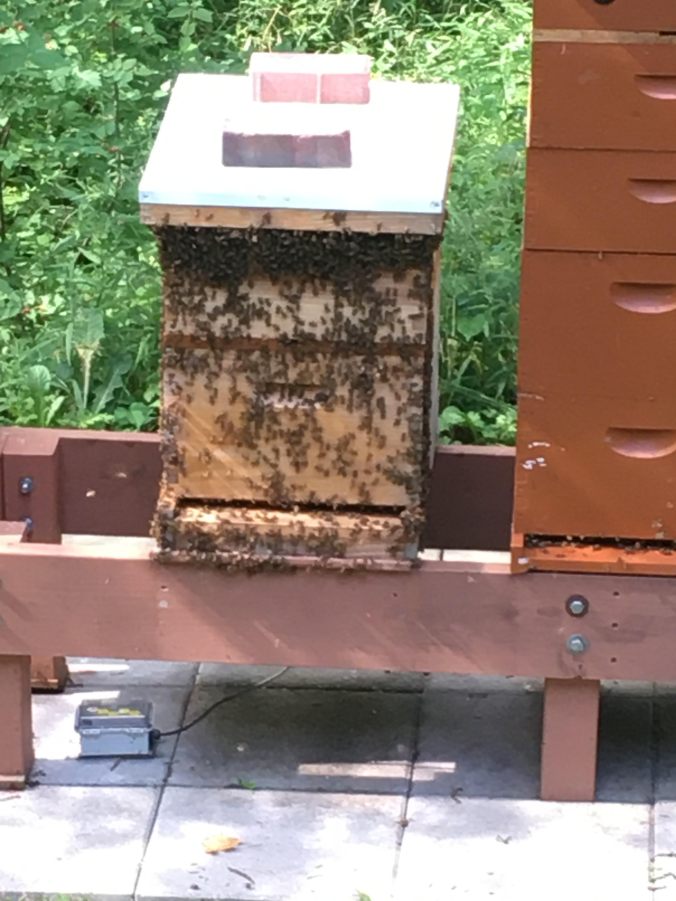
Approaching Saturday’s inspection, we knew we had much to accomplish and had to plan accordingly to make sure we got everything done.
Here was our list:
- Look again in the split (NewBees II) from Buzzers’. If there was still no signs of life, we would need to combine the bees from that hive with one of our other hives. We planned to make that decision but not act on it. If they were doing well, quit feeding and add frames to the box we’d been using to feed from.
- Do a general check on Buzzers’ for queen activity, honey production, crowding, etc. If there were queen cells, we were going to clear the frame of bees and use those cells in the California split since Buzzers’ Roost (II) was an Ohio-raised nuc with a nice fat over-wintered Ohio queen who was a proven layer. If needed, we would add another honey super.
- Check and split California Girls. We decided to do this a little differently than in the past, by just removing one of the boxes after making sure both had eggs. If we found queen cells and/or the queen, we would make sure they went in different boxes, unless we had queen cells from Buzzers’, in which case, we’d scrape off the Cali queen cells and use the Buzzers’ cells instead.
- Feed the split.
- Add another deep to the orginal California Girls and an additional honey super if they were still crowded and their first super was full. The added deep would contain open frames, but also frames with honey and pollen from last year.
- Feed probiotics (Super DFM) to all hives.
- Check and replace beetle hives. The good news is we haven’t seen beetles this year, which we put down to using nematodes. Again, correlation is not causation, but we had real problems with these little nasties, and they disappeared as soon as we started with the nematodes.
- We discussed removing the first supers if they were full, but our schedules preclude extracting in the next week, so it was better to just leave them on.
I think that was the list. We actually made a little flow chart to make sure we got it all.
It was a hot day, so hot, in fact, that we ended up taking a water/cool-off break between the Buzzers’ inspection and California Girls.
First up was NewBees (II).
They had built a little comb between the inner cover and top of the their frames, and filled it with honey. When we scraped it off, they all gather round for a slurp.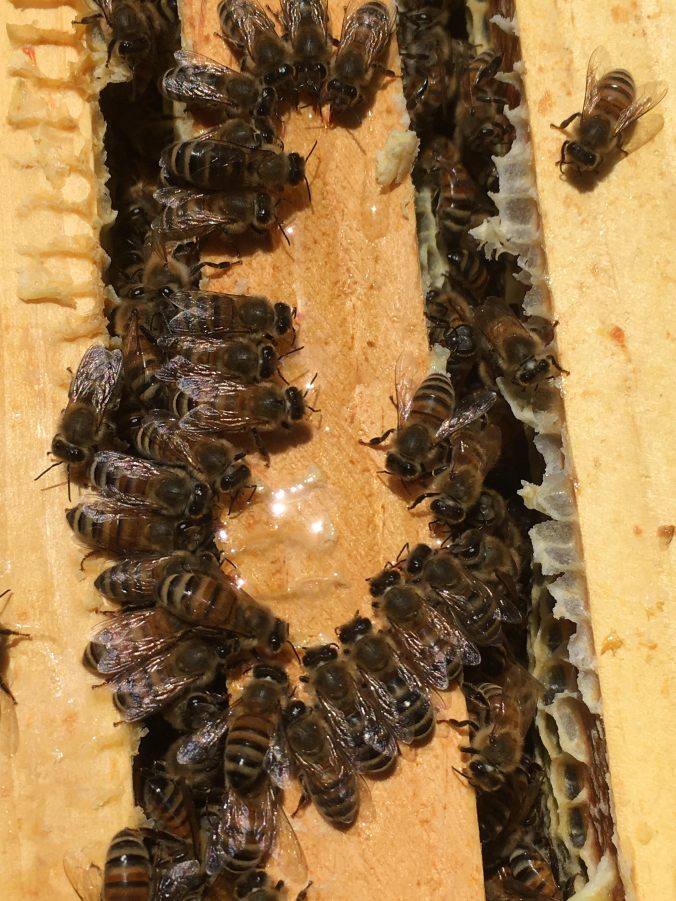
Then, we took a look inside. There were larvae! And … drum roll, please, The Engineer spotted the queen! She was big and beautiful, but moving too fast for me to get a picture.
They were bringing in pollen and nectar, so we took out the food, gave them DFM, added frames, closed the hive up, and left them to it.
Next, we turned to Buzzers’. They also had larvae. I’ve zoomed in and circled them in the picture on the right. Have a look, then enlarge the one on the left, and see if you can spot the larvae there.
There also still had plenty of bees in the hive despite being split a few weeks ago.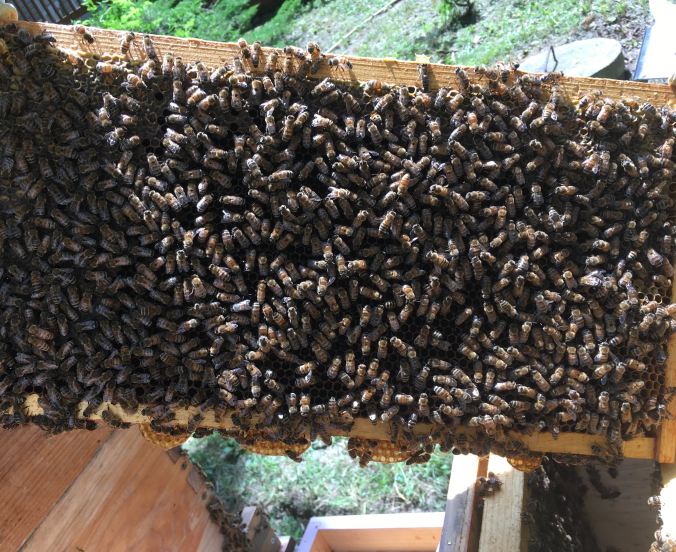
If you look on the bottom of this frame, you’ll see burr comb, which could be mistaken for queen cells if you’ve never seen a queen cell. (Or, like me, you could freak out the first time you see a drone cell.)
Queen cells are shaped more like a peanut. Below are some from last year. The frame on the left is being held sideways (cells would normally be pointed down). Once it gets to the point that they’ve built this many queen cells (and there were many more in that hive), the bees are going to swarm. Ours did despite us splitting them at this point. We were too late.
But, Buzzers’ had no queen cells to steal for for California Girls. In a way, this was good, although it means Cali Girls will have to use eggs to make an emergency queen cell. But the lack of more queen cells means we may have managed to avoid swarming this year.
I’m crossing my fingers because you can never be sure what those girls are going to do.
We also saw Buzzers’ queen, still going strong. Two for two, so far.
I got a nice picture of them festooning on the bottom of a frame, which I’m including simply because I love using the word “festoon.” 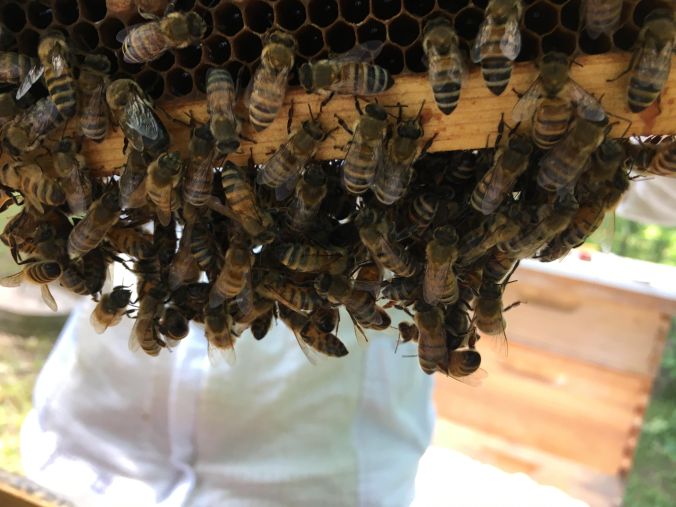
Sometimes, you take a frame out, and they do this between frames, like a bee bridge. Maybe I’ll get a photo of that next time, and I’ll be able to use my newly favorite word again. 🙂
Their honey super was full of beautiful honey, just being capped, so we added another super, and left them to it. We put an empty quilt box on to help ventilate the hive. A recent purchase, a quilt box is mostly used to absorb moisture in the winter, but can also be used now.
We took our drink break here. Feel free to do the same.
Finally, we turned our attention to the wild and crazy California Girls.
Looking inside this hive reminded me of inspecting our FreeBees hive (Summer 2018-March 2020, also Saskatraz), which at I won at Queen Right Colonies‘ Open Day in 2018 .
Like then, there were so many bees they seemed to be boiling up from inside the hive. Not in a bad way — they weren’t aggressive. There were just so many bees.
We’d smoke them so we could pull a frame, they’d go down, and by the time we’d get the frame out, they’d look like this again.
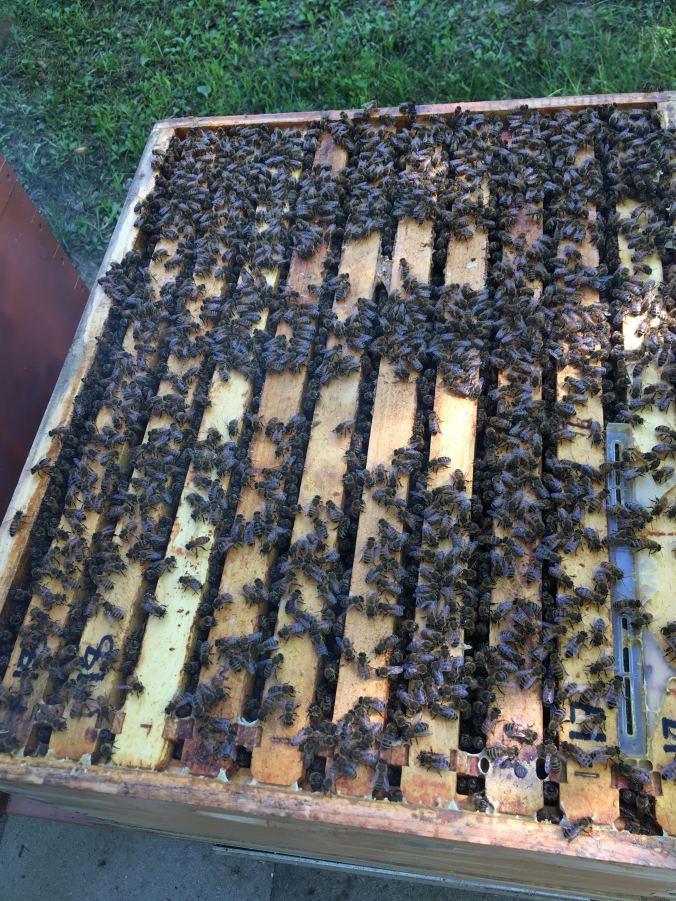 They were also making lots of lovely honey.
They were also making lots of lovely honey.  Clearly, they needed space, and we were there to give it to them.
Clearly, they needed space, and we were there to give it to them.
To make it three for three, we also found this queen. And by “we,” I mean The Engineer spotted all of them. I was most impressed by his finding the NewBees (II) queen because she was both unmarked and fast!
We caught the queen, and put her in the top hive box, which we had moved to make one hive into two. Because there were still so many bees in the box we were leaving for the split, we shook two brood frames of bees from there in with the queen. (By choosing brood frames, a beekeeper ensures most of the bees we shake are nurse bees, rather than foragers who are oriented to the old hive. Nurse bees will be more likely to stay with the new hive and eventually orient to it.)
The super was full of lovely honey, also in the process of being capped, so we added another super, gave them a beetle trap, and fed them some DFM.
Thus, the original California Girls were now in a new place with a setup of two brood boxes and two supers.
The new split remained in place on the hive stand, with a brood box and another box on top to feed from. We ended up putting some frames in that box on either side of the syrup jars because they still had so many bees. We also fed them pollen patties and DFM. Next week, we’ll probably have to fill the second box with frames, or they’ll start building comb, and it will be a mess.
We can put another deep (brood) box on to use for feeding them, or even a super if they’re making a lot of honey, but won’t mess with them too much while they’re making a new queen. It’s a delicate process, plus it’s important not to give them too much to defend if they don’t have enough bees, probably not a problem with these girls.
They looked like this when we were done. Does that look like an underpopulated hive to you? I half think the quilt box should go on this hive!
We are calling them “MayBees” because Maybee they’ll make a queen.
 Our new setup looks like this. Left to right: NewBees(II), MayBees, Buzzers’ Roost (II) (with its quilt box smiley face), and California Girls.
Our new setup looks like this. Left to right: NewBees(II), MayBees, Buzzers’ Roost (II) (with its quilt box smiley face), and California Girls.
Using the picnic table as a stand for California Girls is temporary. It’s several feet high to inspect without a ladder. You probably don’t need to be told this, but it’s not a good idea to be lifting boxes of bees up and down a ladder (slight understatement).
Hive boxes get very heavy. A deep ten-frame brood box (the big boxes) full of honey can weigh eighty pounds, slightly less for brood, and a full ten-frame honey super (medium boxes on top) can weigh up to fifty, so even Buzzers’ is going to be challenging for us (and by “us,” I mean The Engineer) to lift.
Suffice to say, if I were beekeeping on my own, I’d either be using medium and small boxes or eight-frame boxes, probably a combination of both.
When The Engineer made the hive stand (which has proven perfect for our needs (once he shortened it), we thought we were being optimistic in planning that we might someday in the distant future have three hives. We certainly didn’t expect to have four.
Of course, with bees and Ohio weather and Varroa being what they are, that will probably change.

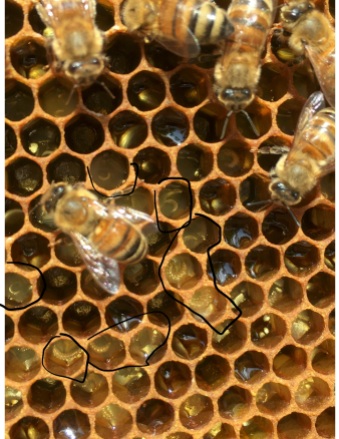


Half science, half witchcraft…. I wish your girls all the best and a prosperous future – all of them!
LikeLiked by 1 person
FIngers crossed. Thanks.
LikeLiked by 1 person
Wow! I’m always amazed at how intricate bee-keeping is!
LikeLiked by 1 person
A good portion of it is making semi-educated guesses. ☺️
LikeLike